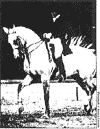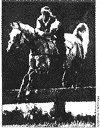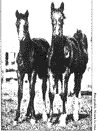Feeding Horses Fat? | Equine Clinical Research
©1991 PRACTICAL HORSEMAN, Reprinted by permission.
PRACTICAL HORSEMAN is published by Cowles Magazine. Subscription rate: $24.95 for one year.
FEEDING FAT
The bad-news for humans turns out to be an efficient performance booster in horses.
By Gary H. Potter, PhD, as told to Sandra Cook
Fat. It's probably not the first word that springs to mind when you think of feed for your horse. Protein, fiber, vitamins and minerals - those are the things you concern yourself with when you buy grain at the feed store or dish out his meals. Fat probably strikes you as something unpalatable; it's the greasy stuff you're supposed to reduce in your own diet, the substance that pads your hips and clogs your arteries.
| Fat is an underrated source of energy for horses; feeding just a small amount of it each day can postpone fatigue, prevent colic, and solve other health and performance problems. |
But while fat may be bad news for humans, who tend to consume more than thirty percent of their daily calories as some form of the stuff, it's good news for horses. The research I've done over the past six or seven years as an equine nutritionist with Texas A&M University has shown that fat holds the key to solving at least part of several problems: It can help horses put on weight without overloading their digestive systems; it can help prevent colic; it allows mares to be bred back more quickly and their babies to grow faster without a negative effect on bone growth; and - perhaps most important for sport horses - it slows down the rate at which horses become fatigued, thereby increasing the time they can perform at their best and reducing their chances for injury.
In this article, I'll tell you how we made our discoveries about the usefulness of fat. I'll explain to you how fat works in your horse's system, and I'll tell you how to feed it to make the most of this often underrated energy source.
HOW FAT FITS IN
Of the three sources of energy for an animal - carbohydrates, protein, and fat - it's well established that fat packs the most punch per unit of weight. A measure of fat provides 2.25 times more calories than does an equal measure of carbohydrates, the most widely used source of energy for horses (carbohydrates are the main energy component of grasses and grains). But fat isn't customarily fed to horses; it occurs only in very small amounts in the natural diet of a mature animal (amounting to about two to three percent of the food consumed), and horsemen don't generally add it as a supplement. That may be because people tend to associate fat with dairy products and meats - substances the horse doesn't eat. He does, however, have the ability to digest fat: As a baby, he drinks his mother's milk, a large part, of which is fat.
I became interested in the potential usefulness of fat during an attempt to discover more information on the nutritional needs of horses in a high state of physical activity. I had made a comparison of equine athletes with humans: Humans reach new levels of achievement every year - and not as a result of genetic selection. But horses, which are bred for specific purposes, aren't breaking records right and left. There had to be an environmental (perhaps nutritional) factor that was contributing to the success of human athletes: one that wasn't being used to help horses.
I decided to focus on fat because, for one thing, my research assistants and I had already taken a look at the way protein, carbohydrates, vitamins, and minerals function; we'd found only limited ways of enhancing performance there. Second, I'd observed that race horses - animals working hard in a high-stress situation commonly have difficulty maintaining or gaining weight. They also tend to be in a chronic state of fatigue, a fatigue that is exacerbated by racing and that leads to injuries that generally occur in the latter part of a race. I felt pretty sure we could help put weight on such horses by increasing the energy density of their feed - that is, by making fat a greater percentage of it. At the same time, we would determine whether increasing the portion of fat in their diets might also help solve the other problems.
It did. Not only did the horses in our research group maintain weight at a lower feed intake, but, at the same heart rate, they ran faster than horses without added fat in their diets. They suffered less severe fatigue for the same amount of work, and they didn't become fatigued as quickly as horses in the control group. These results would, we believed, apply to any horse that had to perform for several minutes at speed or high intensity.
And what about horses that weren't basically runners? We added fat to the diet of cutting horses, and we found that those with a fat-supplemented feed were able to execute more hindquarter turns; that is, they were able to work longer and at a higher performance level than horses that hadn't been given a fat supplement.
While compiling our research results, we were also exploring how fat works in the horse's body. It's that information that explains why fat did so much to improve the condition of the animals in our studies, and it explains why fat can have so much significance for horses in almost every sport - including yours.
| Making Fat Work For You Replacing just a small part of your horse's daily diet (ten percent) will help him derive the full benefits: improved weight gain; lowered risk of colic; increased endurance; and for young horses, increased growth. The following three sample diets will help guide you in making the change for your horse. | ||
 |  |  |
| SHOW HORSE | EVENT HORSE | WEANLING |
| Daily diet: | Daily diet: | Daily diet: |
| 15 lbs. hay | 10 lbs. hay | 10 lbs. hay |
| 5 lbs. balanced grain mix | 15 lbs. balanced grain mix | 10 lbs. balanced grain mix |
| Total: 20 lbs. feed | Total: 25 lbs. feed | Total: 20 lbs. feed |
| Calculation: 5 x .1 = 0.5 lb. | Calculation: 15 x .1 = 1.5 lb. | Calculation: 10 x .1 = 1 lb. |
| Fat-supplemented diet: | Fat-supplemented diet: | Fat-supplemented diet: |
| 15 lbs. hay | 10 lbs. hay | 10 lbs. hay |
| 4.5 lbs. balanced grain mix | 13.5 lbs. balanced grain mix | 13.5 lbs. balanced grain mix |
| 0.5 lb (1 cup) corn oil | 1.5 lb (3 cup) corn oil | 1 lb (2 cup) corn oil |
THE PERFORMANCE FACTOR
When a horse moves, his muscles require fuel to contract. His body meets this energy need in two ways. For most exercise, the horse burns fuel aerobically; that is,he uses the oxygen he inhales to assist in the breakdown of certain materials in his cells to produce energy. Among the substances he can break down are fatty acids - components of fat that circulate in the bloodstream. Another is glycogen, which is a form of starch (a carbohydrate) that is stored in the muscle cells. Because the fatty acids are more readily accessible than stored gylcogen, the horse's body breaks them down first during aerobic exercise, before turning to the glycogen. The second way a horse fuels his activity is anaerobically, or without oxygen. When he's working so hard at high speeds that his demand for energy exceeds his ability to produce that energy aerobically, another mechanism kicks in: He begins to break down the glycogen in his cells. This is the type of metabolism that produces quick energy. (It also produces lactic acid, a substance that has been identified as a cause of muscle fatigue in the horse.)
When a horse is fed a high-grain diet (sixty percent of the total feed) that is ten percent fat, his body after about a three-week adjustment period - starts to metabolize energy in a way that preserves the amount of glycogen in his cells. For aerobic exercise - which makes up most of his daily schooling sessions and much of his competition work - he uses the fatty acids in his bloodstream. Any glycogen that his body obtains from his feed is kept "in storage" in his cells. His reserves build, and when he is called upon to exercise anaerobically, he has more glycogen available.
How much glycogen? In our studies, we tested horses at three stages: first, when they were unfit and untrained; then when they were in training; and finally, when they were in training and on a fat-supplemented diet. Using a needle probe, we took a sample of muscle tissue from each horse and ran a chemical analysis on it to determine how much glycogen was being stored in the tissue. Unfit, the horses had an average of about fifteen milligrams of glycogen in each gram of muscle (mg/g); trained and on a traditional diet, their glycogen level averaged about eighteen mg/g. When put on a fat-supplemented diet, they showed a significant increase in the amount of glycogen stored: On average, they had about twenty-five milligrams of glycogen stored in every gram of muscle tissue. Those extra milligrams are what allow the horse to work harder longer, even though lactic-acid levels in his blood may be relatively high (it seems lactic acid may not be the sole factor in determining the level of fatigue; apparently, the availability of glycogen affects condition significantly, too); they're what allows him to keep going when his body is running anaerobically.
The increase in work time that fat feeds into a horse is small; it amounts to maybe thirty seconds per session. But those thirty seconds can be crucial to a high-performance horse. In a competition, a few extra seconds can make the difference between a fatigued horse and one who keeps going strong; it takes just a short time for a tired horse to hyperextend a joint or strain a tendon.
OTHER BENEFITS
Even if you do nothing more with your horse than go for a hack or jump a few fences, adding fat to his diet can still improve his health and performance.
When a horse gets most of his calories from feed tha'ts rich in carbohydrates, and you have to feed him a hefty portion to keep his weight up, he's in danger of suffering "carbohydrate overload," in which his system can be flooded with the byproducts (mainly lactate) of the digestion of those carbohydrates. Too much lactate can trigger the events that lead to colic and laminitis. And when starches - a form of carbohydrates - are broken down in the large intestine, fermentation results. This fermentation produces gas, which can also lead to colic; the more carbohydrates you feed your horse, the greater the amount of fermentation and gas production, and the greater the risk of colic. But if you feed him a grain mix that's about ten percent fat, you can provide him with sufficient energy while reducing the amount of carbohydrates - thus reducing the chances of digestive disorders.
The fermentation of carbohydrates that produces gas also produces heat - and for a performance horse, too much heat is a problem. When you're working your horse, especially on a hot day and especially if he's overweight, he has to expend a lot of energy to cool himself off - to counteract the heat production of the digestive process and to deal with the heat of exercise. So the less heat he has to deal with (including the heat produced during digestion), the more energy he'll have available for work.
If you have a broodmare, increasing the amount of fat in her diet will increase the amount of fat in her milk, thus increasing the energy density of her baby's diet. (There's also evidence that fat-fed mares may breed back more easily than others, although why that is isn't clear.) In our studies, the fat content of the milk of mares on fat-supplemented diets showed a significant increase over that of mares on non-fat diets.
Why is that good? Well, foals of mares on fat-supplemented diets tend to gain weight more quickly than other foals; in our study, newborns whose dams were fed a grain containing five percent fat gained more weight in the first week of life (1.85 kilograms per day, as opposed to 1.58 kilograms) and had more rump fat at sixty days (0.53 centimeters, as opposed to 0.44 centimeters) than other foals. And growing your baby fast on a high-fat diet doesn't seem to cause bone problems, as high-carbohydrate diets have a reputation for doing: In a study we did with weanlings, those on the fat-supplemented diet showed a higher average daily weight gain than those on a traditional diet (0.80 versus 0.74 kilograms), with no indications that bone growth was adversely affected. (There has been some indication that a high-carbohydrate diet can influence bone growth; an excessive amount of carbohydrates can affect the amount of growth-related hormones in the blood, especially thyroid hormones, and thyroid hormones are currently believed to regulate skeletal growth. If you change the hormone metabolism, the result can be improper maturation of cartilage and bone.)
Perhaps one of the most attractive benefits for horsemen is that feeding fat allows you to feed less. That means you have to store less feed, buy less feed, and dump less feed in front of your horse. And that may save you money.
FEEDING FAT
How do you put your horse on a higher-fat diet? Well, first he has to be getting enough grain to supply his carbohydrate requirements: A balanced grain mix should, by weight, compose about sixty percent of his diet. Next, calculate how many pounds of grain he's getting each day; you want to replace about ten percent of that with fat. (Ten percent is the number we dealt with in our studies because it made for a manageable addition of fat; whether a greater amount of fat increases benefits isn't known yet.) Your horse's hay ration should remain the same - hay is a necessary source of roughage and other nutrients; your goal is to replace the grain that's the source for most of his carbohydrate-based energy. The calculation is simple: Take ten percent of whatever your horse's grain weighs and replace it with the same weight of fat. For example, if your horse is getting fifteen pounds of sweet feed and ten pounds of hay each day, on a fat-supplemmented diet you'd feed him thirteen and a half pounds of sweet feed, one and a half pounds of fat, and ten pounds of hay.
Which form of fat do you add to the feed? Most barns have a jug of corn or vegetable oil in the feed room, and either of those oils can be used; the liquid is pure fat. Vegetable oils tend to be expensive, however (try buying them in restaurant-size containers for a better price), and a pound and a half of oil - about three cups - may make your horse's manure loose. For our research, we used animal fat: It's less expensive than vegetable oils (roughly fifteen cents a pound unprocessed); and in its powdered form (available at most feed stores), it's easier to handle. You could use lard, but cutting the fat into your horse's feed can be a little messy.
The other way to add fat to your horse's diet is to try one of the new feeds that contain a high percentage of fat in pelleted or extruded form. Such feeds are convenient, but because fat becomes rancid quickly (a good reason to add it to feed meal by meal and not to buy more than you need for a two-weeks' supply), preservatives have to be added to such feeds - and that increases the cost.
Whatever the form of fat you choose to add, you'll be helping your horse. He'll have more energy for hard work and competition, and a lesser chance of falling victim to the problems that plague performance horses.
Garry H. Potter, PhD, is Professor/Equine Program Leader and nutritionist at Texas A&M University. He is also a member of the National Research Council's Subcommittee on Horse Nutrition.